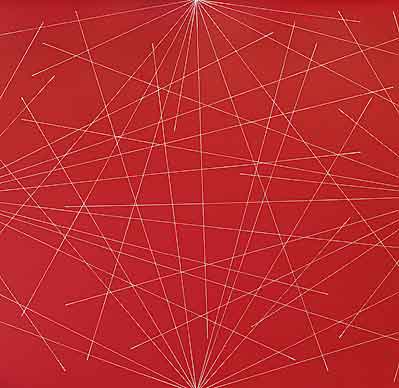

For the first time in Belgium, M gathers twenty-four color wall drawings by the American conceptual artist Sol LeWitt .
Sol LeWitt. Colors
June 21–October 14, 2012
M - Museum Leuven
Vanderkelenstraat 28
3000 Leuven, Belgium
www.mleuven.be
For the first time in Belgium, M gathers twenty-four color wall drawings by the American conceptual artist Sol LeWitt (1928–2007). Based on LeWitt's detailed instructions and plans, the works are executed on site, directly on the walls of the exhibition space. The monumental drawings, while reminiscent of the Italian Renaissance fresco tradition, mark a groundbreaking departure in the history of contemporary art. For LeWitt, the idea or concept behind an artwork is primary, the execution secondary: "In conceptual art the idea or concept is the most important aspect of the work. When an artist uses a conceptual form of art, it means that all of the planning and decisions are made beforehand and the execution is a perfunctory affair. The idea becomes a machine that makes the art" (Sol LeWitt, "Paragraphs on Conceptual Art," in Artforum, June 1967).
Chosen from the ca. 1200 wall drawings created by the artist between 1968 and 2007, the exhibition at M offers a selective overview of LeWitt's radical practice. The works presented here, exclusively in color, have been selected in close collaboration with the LeWitt Collection, Chester, Connecticut, ensuring that each piece perfectly embraces the museum's architecture. The making of the wall drawings at M has been the occasion of an exceptional collaboration between professional drafters trained by the LeWitt studio, local artists, and 61 students from various Belgian art schools.
The selection of works dating from 1969 to 2003 follows overall a chronological order, from the earliest drawings made up of thousands of fine pencil lines, or bolder lines and simple geometric shapes in crayon, to more complex shapes in India ink washes, and finally exuberant systems in acrylic paint. With a distribution of the wall drawings in four consecutive rooms, each corresponding to a medium used by the artist, the exhibition provides an articulated overview of the evolution of LeWitt's practice. A fifth gallery concludes the exhibition with two works mainly in black and white, hinting at both the diversity and consistency of LeWitt's body of work. Furthermore, they link Sol LeWitt. Colors at M to its partner exhibition, Sol LeWitt. Wall Drawings from 1968 to 2007, at Centre Pompidou-Metz, featuring over thirty of LeWitt's wall drawings in black and white.
Curators
Béatrice Gross (Independent curator, New York) and Eva Wittocx (Chief Curator, M-Museum Leuven)
Sol LeWitt. Wall Drawings from 1968 to 2007
March 7, 2012–July 29, 2013
In partnership with M-Museum, Centre Pompidou-Metz presents a retrospective exhibition, which features over thirty black and white wall drawings.
Curator: Béatrice Gross.
www.centrepompidou-metz.fr
Also at M - Museum:
Ines Lechleitner
Objets Réposés
June 8–September 2, 2012
The work of Ines Lechleitner (b. 1978, Vienna) encompasses such varied media as photography, video, installation, and drawing. In her work, she analyses the correlation between different forms of communication, such as sound, image, and text. Along with a number of other artists, writers, and academics, Lechleitner's current project concentrates on questions concerning sensory translation. How is one sense connected to another? How can someone else summon up a sensory experience? M is exhibiting a selection from the series Sense Correspondence, as well as a site-specific installation: an ode to the LeWitt exhibition.
*Image above:
Sol LeWitt, Wall Drawing #299 (detail). The wall is divided into three equal parts, each with a different color. A 6-inch (15 cm) grid covering the wall. First part: On red, white lines from the midpoints of each side to points on the grid. Second part: On yellow, white lines from the center to points on the grid. Third part: On blue, white lines from the corners to points on the grid. Each part has an equal number of lines. (The number and their length are determined by the drafter.) White crayon lines, black pencil grid, red, yellow, and blue wall. First drawn by: Jo Watanabe. First installation: Fort Worth Art Museum, Texas. November 1976. Collection of Levi Strauss & Company, San Francisco © SABAM / M-Museum Leuven, Photo by: Lieven Herreman.